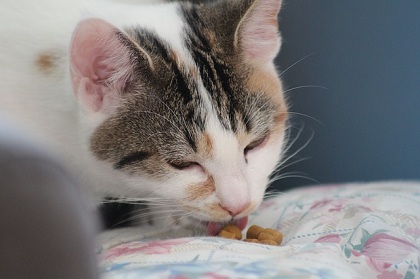Food Allergies in Cats
Food Allergies in Cats
Food allergies in cats are the third after allergies caused by fleas and inhaled substances. They make 10 percent of all allergies in cats and dogs. Even though there are reliable techniques and medical tools to diagnose food allergies, the symptoms are not easy to recognize. Namely, the common symptoms of food allergies are itching, bald patches, digestive problems, and dermatitis. Vomiting and diarrhea are not unusual for food allergies, but they rather imply that a cat has developed food intolerance. As we have seen, the symptoms of food allergies are similar to other feline diseases such as atopy, fleas, parasites, gastritis, kidney failure, liver disease, pancreatitis, various infections, and so on. Because of that, cat owners rarely suspect on food allergy, especially if they did not change cat diet for years. According to feline experts, many cats become allergic to the very food they eat too long. It is hard to notice food allergy because the symptoms need time to express themselves gradually. The foods that usually cause food allergies in cats consist of beef, lamb, seafood, corn, soy, dairy products, wheat, chicken, eggs, and pork. For that reason, veterinarians recommend diets without these products. There are commercial diets made of duck and potatoes. Feline experts recommend feeding a cat for 12 weeks with this food and then, slowly introduce some of the foods before. The introduction also needs time, and the foods should be reintroduced one by one. To find out more about food allergies in cats, the article “Cat Food Allergies” gives us the following tips what to do if a cat has food allergy.
Food Allergies in Cats
“First consult your vet to determine if your pet has a food allergy or intolerance,” says Mark Finke, Ph.D. and a pet nutritionist. “Then try a premium food with a limited number of protein and carbohydrate sources.” Ask a PetSmart associate for recommendations on our best foods.
Your vet may also suggest a prescription food. To transition your pet to the new cat food, mix a small amount of the new food with the current food and increase the new food over the course of 10 days.
Also:
Avoid foods with the leading protein allergens for cats including beef, fish and dairy.Avoid treats and people food.
Feed your pet the new diet for four to 12 weeks and document the type and amount of food your pet eats and any reactions they have. Review your notes with your vet, noting any changes in your pet’s symptoms.
Even though treatment of food allergy might be long and tiresome, it is important to apply the process of trial and elimination to help a cat feel better. Food allergies do not represent serious health problems, but the difficulties and health issues that emerge from them might be dangerous. To go through the process, we need love and patience. But after we determine what food has caused allergy in our cat, by avoiding it, we will free the cat from very uncomfortable consequences and help her/ him to have a long and happy life.










